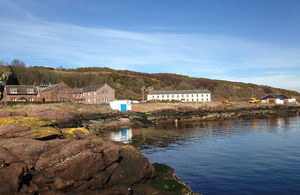Marine Station, Isle of Cumbrae, Ayrshire
Upgrading and refurbishment of national research facility, Millport Marine Station, on the Isle of Cumbrae in Ayrshire, to increase its use by UK and overseas universities as well as supporting the local economy.

A view of Millport Marine Station
Project summary
| Nearest NDA site | Duration | Total investment | NDA/Magnox Ltd contribution | Partners | Delivered by |
|---|---|---|---|---|---|
| Hunterston A | 2014 to 2015 | £9.5 million | £300,000 | University of London, University of Glasgow, Marine Alliance for Science and Technology Scotland, Highlands and Islands Enterprise, North Ayrshire Council, Cumbrae Community Development Company | University of London |

Infographic summary of the project
Outcomes:
- new teaching labs and lecture room facilities
- refurbished high quality en-suite overnight accommodation
- new accommodation building
- joint venture with St Andrew’s University to develop academic and commercial opportunities
- safeguarding of 29 current jobs
- creation of least 12.5 new full-time jobs
- seasonal employment opportunities
- overall economic impact estimated to be £2.6 million for North Ayrshire and £3.1 million at the Scottish level
- forecast 40% increase in business for 2019
- increase in visitor numbers to more than 5,000 a year
- boost to fragile island economy and nearby businesses
Key objectives:
- expand the number of UK and overseas universities using the Marine Station for all levels of study, from undergraduate to PhD
- increased research collaboration
- increased used by schools
- attract business users
- open up the facility to leisure visitors and improve public understanding of science
Why was this project important?
Built in the 19th century, the internationally renowned marine station provides a wide range of fieldwork options for academic research and is a valuable asset for the UK and North Ayrshire in particular. It is the only higher education institution in the region and a key local employer. Many of world’s leading marine biologists have visited the marine station.
What was involved?
Despite its world-wide reputation, the University Marine Biological Station Millport, which was supported by the University of London in partnership with Glasgow University, closed in 2014 when higher education funding was withdrawn. It re-opened under the ownership of the charity Field Studies Council (FSC), and was re-named FSC Millport. Among the improvements were new classrooms and accommodation to cater for school and university visitors undertaking field studies as well offering family activity holidays.
What worked well?
Group visits now include universities, schools, conferences and professional training, while the range of learners has extended, as well as the range of universities making use of all the facilities.
What could be improved?
There is scope to enhance the facilities further to generate additional use by members of the public and visiting tourists.
Next steps
Implementation of Phase 2, involving construction of new aquarium, further improvements to teaching facilities, dining room extension and climbing wall.